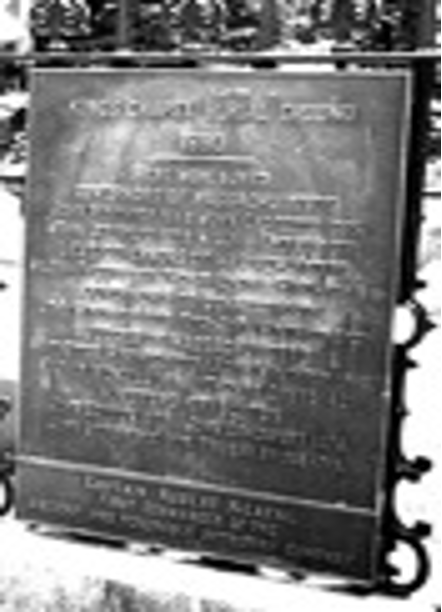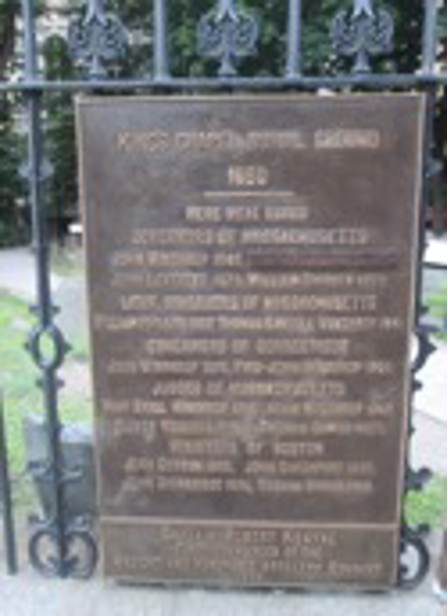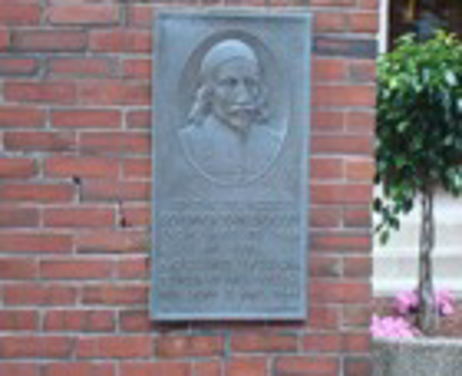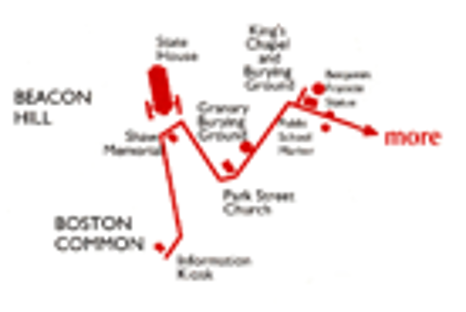Introduction

There has been, over the years, confusion and even some disagreement on the exact resting place of Governor John Endecott who arrived in Naumkeag (later Salem) on September 6, 16281 and was the First Governor in the Massachusetts Bay 2 3 4. Most genealogists, biographers and historians who study colonial history have concluded that the British destroyed many tombstones in and around the Boston area.

Part of the confusion had resulted in the placement of the commemorative plaque on the fence at the Kings Chapel Burying Ground on Tremont Street along the Freedom Trail in Boston. The inscription on the plaque had included for many years the name of Governor John Endecott, Esq. as being buried there. That had been incorrect. There never was any evidence that Governor Endecott was interred at King’s Chapel. Unfortunately, over the years, many made the visit to Boston and went to the King’s Chapel thinking they were at the historical and final resting place of Governor Endecott. In the Spring, 2011 and at the request of the Endecott- Endicott Family Association, Inc., the City of Boston finally recognized this historical error and has made the necessary correction.
During some research at the New England Historic Genealogical Society in February, 2006, this author had the opportunity to discuss and research this question of the burial of Governor Endecott. David Lambert, a noted genealogist and expert on ancient burial grounds in Boston, helped provide extremely valuable insight into the Governor’s burial. He also provided excellent source documentation that helped lead to resolving this mystery
Residence, Death and Burial of John Endecott
Previously, John Endecott had lived on his beloved Orchard Farm in Danversport. However, at the request of the Council of Magistrates, he removed to Boston in 1655 leaving at “the farm” his wife Elizabeth (Cogan) Gibson Endicott (1611-1676) and his sons John (1631-1667) 6 and Zerubbabel (1635-1684). The Council required that their Governor reside in Boston.

Incidentally near this site is another marker commemorating the home of Rev. Cotton Mather (1663–1728). Within a few short blocks near the Old State House and on State Street is yet another historic marker showing the home of John Winthrop (1587/8–1649).1011 Winthrop was a contemporary of John Endecott. Winthrop was Governor in 1630 subsequent to John Endecott in 1629. Winthrop, as the second Governor, and his burial site is appropriately recognized at the King’s Chapel Burying Ground while the burial site of John Endecott, the first Governor, at the Old Granary Burying Ground is not.
John Endecott died in Boston, MA on March 15, 166512 In Lawrence Mayo’s book, Biography of John Endecott, he quotes from the works of John Hull, master of the mint who wrote in his diary on the date of Endecott’s death –
Our honored Governor, Mr. John Endicott, departed this life, - a man of pious and zealous spirit, who had very faithfully endeavored the suppression of a pestilent generation, the troublers of our peace, civil and ecclesiastical, called Quakers. He died poor, as most of our rulers do, having more attended the public than their own private interest. It is our shame: though we are indeed a poor people, yet might better maintain our rulers than we do. However, they have a good God to reward them.13
In May of 1665, the Court, in “remembrance of the good service of the late John Endecott, Esq., Governor”, approved payment by the Treasurer for the expenses of the Governor’s funeral and burial. At the same time, the court approved the expenses for reimbursement to Mrs. Endecott for mourning cloths for herself, children and family. 14
In the study and writings of William C. Endicott, Jr., he states that “the Governor ‘with great honor and solemnity was interred in Boston and was probably buried in the Governor’s tomb, Granary (South) Burying Ground. Family tradition says King’s Chapel Burying Ground on the left entrance to the Church and that the stone was destroyed by the British soldiers at the time of the Revolution. This statement was made by Timothy Endicott, Esq. (1775-1865) to his nephew William Putman Endicott, Esq. (1805-1888). Dr. Samuel A. Green, Librarian of the Massachusetts Historical Society, says King’s Chapel”.15 These two statements are incorrect.
In Lawrence Mayo’s book, Biography of John Endecott, he states that “here and there one comes upon the statement that Governor Endecott was buried near King’s Chapel under what is now the sidewalk in front of that building. But, lately the northwest corner of the Granary Burying Ground has been established as the true location.” 16
Granary (South) Burial Ground
After King’s Chapel Burying Ground closed in 1660, the Granary Burying Ground was opened and laid out in 1660 and the first tombs were built in the northwest corner.1718 This fact 1718 along with the death of John Endecott in 1665 lends to the credibility that he is not buried at the King’s Chapel, but is interred at the Granary
While attending the NEHGS Come Home to New England Conference in August, 2003, this author had the opportunity to visit the Granary Burying Ground. Afterthe visit, one of the Boston Park Rangers offered to investigate the records in the Ranger’s office on the Boston Common to see whether there were any existing records on the burial of John Endecott. After a review of the computer records of all known burials and a large sectional map showing each burial, there was no record of the burial of Governor John Endecott.

Among those listed from a website of the Old Granary Burying Ground as being buried here includes: ENDECOTT, John b. 1588. d. June 15, 201665 - This site does not provide a source citation of this listing for John Endecott. (Note: The date of death of June 15 is incorrect. It should be March 15.)
The Rare Books and Manuscripts Division at the Boston Public Library were consulted in April, 2006. Within this collection were May’s copies of Boston cemetery inscriptions and records 1895-190821 and Billings’ (City of Boston surveyor) plan of the Granary Burial Ground 21 of December 31, 1904.22 Neither of these works showed any evidence of Tomb # 189 of 22 Governor John Endecott.
Previous Prevailing Views
As previously mentioned, two prevailing views have existed regarding the burial site of Governor John Endecott. They are family lore (tradition) and the inaccurate placement of the commemorative plaque at the King’s Chapel Burying Ground inscribing the name of John Endecott, Gov. as being interred there. Both have been incorrect. Many do, however, believe and accept the idea that the British destroyed many burial stones during the American Revolution, including that of John Endecott. On the other hand, many tombstones did survive the British. Other possible thoughts on missing tomb stones at the Granary Burying Ground are that “in early times, cows grazed freely among the stones. Selectmen’s minutes of 1678 show grazing rights, a source of revenue, allowed to John Woodbury. That changed by 1713 as selectmen voted to make James Williams responsible for any damages which may happen to the graves by reason of his cows going there” 23 Also, it has been suggested that the British used many tomb stones to carry their wounded soldiers to be cared for.
Recent Discoveries
During the February, 2006 visit to the New England Historic Genealogical Society, two important discoveries were made settling the question of Governor John Endecott’s burial. These discoveries were:
A.Records of Boston Selectmen, 1722
In an extract of the City of Boston Selectmen’s Minutes of March 26, 1722 it is recorded that “Upon a petition of Mr. John Edwards of Boston Sheweth. That whereas there is a tomb in the South Burying Ground place belonging to the Late Governour Endicott, which has bin unimproved for many years, and there being no family in Said Town nearer Related to the Said Governour Endicott family then his, Desires he may haue Liberty granted him to make use of it for his family. Granted that the Said John Edwards his liberty to Improuse the Said Tomb until a person of Better Right to it appears to Claim it." 24 Then, the questions became: Who is this John Edwards? Why had the tomb of John Endecott not been maintained by any member of his family in the past 57 years? Was there no interest of those descendants (2nd and 3rd generations) still residing in Salem? Why had the City of Boston not taken interest in maintaining the tomb of their First Governor in the Massachusetts Bay? What was the condition of the tomb at the time of the petition of John Edwards? Was this site not significant in that other famous historical figures were also buried there even those at a later date? These and other questions will probably never be satisfactorily answered.
B. John Edwards, Jr. Connection
Further research into who was John Edwards was in order. What was his specific interest in the Governor’s tomb at the Granary (South) Burying Ground? Further research did answer this question. John Edwards, Jr. was the brother of Anna Edwards of London, England. Anna had 25married about 1680 to John Endecott (1657- abt 1695) , the grandson of Governor John 26Endecott. Robert Edwards Endicott was a son of John and Ann Endicott and was baptized on April 11, 1693. Furthermore, “the John Endicott, whose children were baptized in the parish of St. Olave, Hart Street, in 1689 and 1693, was Dr. John Endicott, a grandson of Governor John Endicott of the Massachusetts Bay. After Dr. Endicott’s death, his widow Ann and these two children came to New England. The daughter, Ann, married in 1771 to her cousin, Samuel Endicott; and her brother Robert Edwards Endicott, married in 1770 to Elizabeth Phillips.” 27William C. Endicott, in the early 1900s, conducted some extensive research on the tomb of Governor Endicott. Endicott states “the tomb has been handed down since his (John Edwards) death in 1746, through the descendants Cheever, Derby and Shattuck”. An ancient plan of the burying ground gives an exact location of the tomb. Endicott continues to write that “the present monument (1918)is built of red-faced brick with a white marble slab on the top which has the following inscription cut on the marble slab:
Tomb of William Downs Cheever Repaired by John Derby 1803 Restored by George Cheyne Shattuck 1852” 28
Tomb # 189 Old Granary Burying Ground 29 Ownership of Tomb # 189; Family Relationships (Propinquity) and Other Non-Family Burials. Information from the Inscriptions and Records of the Old Cemeteries of Boston also shows 30 the inscription, as noted above. In addition to this reference of the Tomb # 189 inscription, this reference also provides some important historical information on the ownerships and burials of Tomb # 189: 31
Owners: Governor John Endecott, John Edwards
Mary Beath, wid, fam. Mary, July 7, 1837, ae. 45 y. Tomb 189
Elizabeth Derby, Sept. 11, 1831, ae.73 y. Tomb 189
John Derby, fam. John, Dec. 5, 1812. ae. 72 y. Tomb 189
Richard Derby, Capt., June 6, 1832, ae. 67 y. Tomb 189
Prince Eastman, colored, from Dorchester, Apr. 5, 1821, ae. 63 y. Tomb 189
Eliza Peirce, fam. wid. John Derby, Dec. 10, 1815, ae. 23 y. Tomb 189
“On May 31, 1904, through the courtesy of the owners, Dr. George Brune Shattuck, Dr. Frederick Cheever Shattuck and their sister, Mrs. Alexander Whiteside, nee Shattuck, William Chrowinshield Endicott had this tomb No. 189 opened. No trace was found that this was the burial place of the Governor though the tomb was evidently a very ancient one judging from the brick work and the small size of the entrance.” 32
According to the Celebrate Boston web site and the link for John Endecott Colonial Massachusetts Governor it is stated “Endicott was interred at the Granary Burying Ground in Boston. By the mid-1700s his tomb had fallen into disrepair and ownership was assigned to John Edwards because Endicott had no living descendants. The Edwards family was related to the Cheevers by marriage, so the current Cheever tomb is very likely Endicott’s original resting place”. This information of the Edwards – Cheever connection was obtained from the Boston Almanac, 1840. 33
An ongoing study since this article was first published in May, 2007, has been the family connections of the Edwards, Cheever, Derby and Shattuck families connecting back to Governor John Endecott. This genealogical family kinship (propinquity) study to date, leads us to 1999.
Description of Tomb # 189
David Lambert describes the Governor’s tomb as being underground with the placement of the brick work and marble slab (tablet) top upon a burial ‘room’. The tomb had an entrance with stairs leading down into the ‘room’. At the entrance of the ‘room’ was probably a hinged locked door which required then a skeleton key. Upon entering the subterranean tomb ‘room’, there could have been several ‘caskets’ resting upon wooden poles against or along the wall of the tomb ‘room’. In addition to this verbal description, the following diagram was included in the Fall, 2010 Newsletter of the Boston Historic Burying Grounds Initiative An additional piece of 34 important information contained in this newsletter is that in 1904, the City of Boston only owned two tombs in the Old Granary Burying Ground 35
It is believed that this diagram and the description provided by David Lambert is representative of the tomb of Governor John Endecott and others interred in Tomb # 189 at the Old Burying Ground on the Freedom Trail in Boston, MA.
Conclusions
It appears that the interest of John Edwards in the tomb of John Endecott was threefold. First, he was connected to the Endicott family through his sister Anna who was residing in England. Secondly, it is assumed that since he lived in Boston, he was encouraged by the Endicott family members in London to improve upon and preserve the Governor’s deteriorating gravesite. And thirdly, he was planning and making arrangements for his final resting place. The death of John Endicott in 1665, later the death of John Edward in 1764 and the provenance study of Tomb # 189, the ownership of this tomb have been reasonably proven up to 1904 – a 239 year time period.
With reasonable certainty, this research provides evidence on the resting place of one of the most important Colonial figures in the founding of a new country – John Endecott, the Puritan and First Governor in the Massachusetts Bay. It also shows the erroneous information of others indicating the King’s Chapel and the prior incorrect plaque at the King’s Chapel about Governor John Endecott’s burial.
Further study and research is warranted, but not limited to:
1. Determine the ownership of Tomb # 189 at the Old Granary Burying Ground from 1904 to the present (the next 108 years – the continued provenance study)
2. Research and verify the current monumentation on all of the colonial Governors buried at the old Granary Burying Ground and the Kings Chapel Burying Ground.
Interpretative Panel # 5
In 2004, the City of Boston erected interpretative panels at the Old Granary Burying Ground. Interpretative panel #5 acknowledges that John Endecott is buried at Tomb # 189. However, the City of Boston has not been supportive on the appropriate historical monumentation to be placed at or on Governor John Endecott’s tomb. For years and up to today, there is no monumentation of the Governor’s tomb or even a marker indicating # 189. This makes it difficult to find the Governor’s tomb. The interpretative marker provides for a major disconnection and confusion in the panels orientation to Tomb # 189. This further complicates the visitor finding the correct tomb of John Endecott. One Commonwealth of Massachusetts official visited the Granary attempting to locate the burial site of Governor Endecott and was unable to do so. This state official indicated that the interpretative panels were “dreadful”. Another recent example was a Boston born native and descendant of Governor Endecott who also could not find the Governor’s final resting place. Until which time the City of Boston recognizes this continued problem, others will experience the same difficulty in locating the First Governor of Massachusetts.
As previously discussed, the City of Boston agreed (in January, 2010) to correct the plaque at the King’s Chapel to help eliminate the long standing confusion on the true burial site of the first Governor of Massachusetts. This part of the years long confusion has been corrected.
A historically accurate commemorative marker should be designed and appropriately placed at the correct location – Tomb # 189 - of Governor Endecott’s burial in the Granary Burying Ground. The Endecott-Endicott Family Association, Inc. would be extremely interested in pursuing a partnership in co-sponsoring and participating with the City of Boston, the Commonwealth of Massachusetts and others interested in this historically important preservation project. It is hopeful that Endicott Cousin researchers and those interested in the colonial Governors will benefit from this research. Furthermore, it is believed that the City of Boston, by their commitment on the placement of a plaque at or on Tomb # 189, will finally recognize the historical accuracy; significance and the necessity to honor the final resting place of John Endecott, the first and longest serving Governor in Massachusetts history. Governor Endecott was also Major General of the colonial militia 1645-1649. 36
The citizens of the City of Boston; thousands of visitors to the Old Granary Burying Ground on the Freedom Trail and all of the descendants of John Endecott deserve the historical correctness versus the position shown by the City of Boston. We remain hopeful and optimistic that the Boston imposed obstacles can and will be overcome with the right common sense intervention.
Massachusetts National Guard at Tomb # 189 for the Endicott Cousins wreath laying ceremony – June 18, 2012 5th National Endicott Cousins Reunion